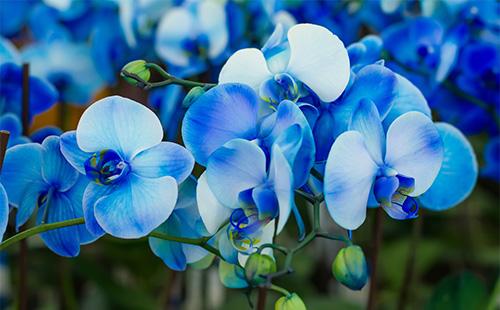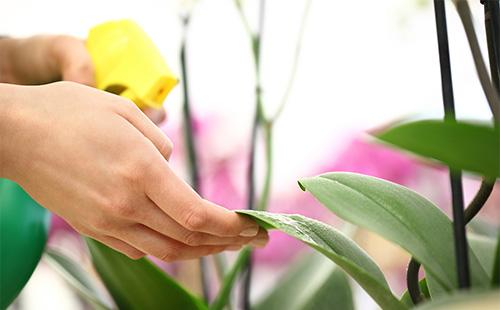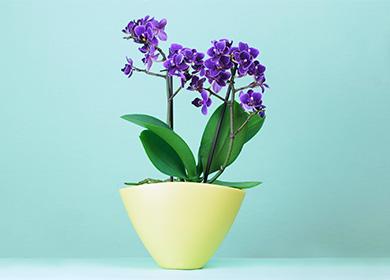The content of the article
Exotic lovers will be very disappointed - most of the blue orchids on the shelves are painted artificially. There are several hybrid varieties of blue, but it is not so bright and saturated.
Special grades
Blue archidea - painted or natural? There are only two varieties of orchids with an unusual blue color - these are Wanda and Cattleya. Wanda - a capricious flower, requires increased attention to itself. The color is not quite blue - with a purple tint. But Wanda looks no less spectacular than colored flowers.
Cattleya is less demanding in care. It features large bright colors. The colors are different, among them there are varieties with pale blue flowers. The saturated blue color of orchids in nature does not happen. Flowers are stained by watering or dye injection. It will not work to keep the blue color - the following flowers will be slightly bluish or completely white.
Actions after the purchase
Care is complicated by the weakened state of the plant. The introduction of artificial dye is a powerful stress for the flower. He will need increased attention, enhanced care, so that he can adapt to new conditions.
Do not rush to transplant the orchid into a new pot. This is an additional stress. It is too likely that the flower will die soon after the transplant.
If too many chemical dyes have been introduced, the flower will gradually drop its buds. He urgently needs to be reanimated. Carefully inspect the plant from the peduncle to the roots. Look for traces of injections. Finding them on the roots is a bad sign. There is no guarantee that the orchid will be saved. The paint was introduced into the peduncle - the chances of survival of the plant are greater.
Resuscitation of a painted flower
- Find the injection site. And carefully, with a sharp knife, cut the flower stalk filled with paint.
- Remove the orchid from the pot. Free the roots from the substrate. Rinse the root system with warm water.
- Inspect the roots. If cyanotic, rotting areas are found, cut them out. Treat the cut points with cinnamon or charcoal powder.
- Dry the roots. During few hours.
- Transplant. Into a new sterile substrate.
Basic care
Painted flower will require more careful care. Violation of the rules will lead to death.
- Lighting. Sunny places are not suitable. On the south side they put on a table a little further from the window. Preference is given to the northeast, west and east side. In the afternoon hours, they shade.
- Temperature. In a light shade, at moderate temperatures of 18-25 ° C, flowering will last longer. In summer, a short-term temperature increase of up to 35 ° C is allowed.Prolonged heat leads to dropping buds and lethargy of leaves. A plant weakened by dyes may not tolerate the heat. In winter, the temperature is reduced to 15-25 ° C. Withstands short-term cooling to 12 ° C.
- Humidity. Normal is considered a humidity level in the range of 30-40%. Increased humidity and poor ventilation leads to rotting of the roots and the appearance of spots on the leaves. With humidity below 20-25%, the leaves lose turgor, the flowers fall. Accurate spraying is beneficial. But try not to allow water to accumulate in the axils of the leaves.
- Watering. Watering is necessary taking into account the real plant variety. White phalaenopsis is most often stained, so watering should be regular. Full drying of the soil is not allowed, but waterlogging, too. In phalaenopsis, wet roots turn green.
- Top dressing. It is better not to feed the painted orchid or use a minimal amount of fertilizer of low concentration. One of the most successful fertilizers is Kemira Lux.
- Root care. Air roots are not buried in the substrate. They are needed for additional moisture and nutrition from the air. Old roots gradually die off - turn brown, dry out. The dried parts are carefully cut with a sharp knife.
- Priming. The main component of the substrate for most orchids is the pine bark. In dry rooms, sphagnum is added to the substrate - it retains moisture well. You can add a little crushed foam and coal. Before planting, the bark is soaked for two days, washed with clean water and only then mixed with the rest of the components.
- Transfer. Take your time with the transplant. It is worth it if the roots are damaged or the substrate is in poor condition. Transplanted after flowering at intervals of two to three years.
Home dyeing
Why did the blue orchid become a different color, can I recolor it? It is undesirable to paint orchids, since any coloring matter poisons them. In extreme cases, use special paints for flowers. They can be purchased at large flower shops or ordered online. The action algorithm consists of four stages.
- Dissolve paint with water. In accordance with the instructions.
- Take a sterile syringe. And fill it with dye.
- Gently pierce the peduncle. And enter the coloring solution.
- Treat the puncture site. Coal powder.
At first, carefully monitor the condition of the plant. Keep it in a cool room, in moderate light, monitor the condition of the soil. If the flowers turn blue, do not wilt, the plant looks healthy - the experiment was a success.

Color change effects
Any paint contains aggressive chemicals. Their introduction into the peduncle does not go without consequences.
- Violation of gas exchange. The capillaries are clogged, the plant can not fully breathe.
- Diseases and pests. Natural immunity is lost, resistance to diseases and pests is lost. Sores, rot may appear at the injection site. When dye is introduced into the roots, they inevitably decay.
- The death of the plant. This is the most frequent outcome of an experiment. At best, it is partially restored, but still remains weakened.
Care after flowering for a painted orchid will be slightly different. The flower stalk is better to cut off immediately, without waiting for the re-formation of buds or children.It will take longer to recover. The flower needs to provide the most comfortable conditions.
Breeding methods
If you bought not a Vanda or Cattleya, but a painted orchid, focus on the method of propagation of phalaenopsis. It is propagated mainly by children and cuttings.
Cuttings
Cuttings are an effective, fairly simple way. Cuttings are cut only from a healthy plant that is not affected by pests and diseases. Take a side shoot.
Cut it into several parts. On each leave two nodes with axillary kidneys. The tank is filled with wet sand or sphagnum moss. Cuttings are laid horizontally. The container is covered with a film on top.
Growing out of kids
Children develop from dormant kidneys. Formed on the stem, peduncle. Independently, children rarely form. Usually their development has to be stimulated. Several methods of stimulation are used.
- Division of the main plant. The method is risky, suitable only for completely healthy plants. In the case of colored orchid, it is better not to use it. The essence of the method is to cut off and root the top. The lower part is continued to be looked after until the appearance of children with roots.
- Reduced watering and temperature differences. Watering is stopped for 15 days, achieving a daily temperature difference of 7-9 ° C.
- Hormonal stimulants. Flower shops sell special hormone paste. With its help, you can quickly wake a sleeping kidney, stimulate the formation of children from it. Coverweed is removed from the upper bud of the peduncle. They work neatly, using a sharp blade and tweezers. Every four days, a sleeping kidney is treated with paste. The orchid is kept in a warm room at a temperature of up to 30 ° C. In the cool, instead of the children, a bud is formed. The grown children are separated from the peduncle and planted.

Frequent diseases
The probability of a colored orchid disease is much higher. At the slightest sign of illness, treatment is started immediately. The chances of surviving a weakened plant are much less. Below is a table with the symptoms of the underlying diseases and their treatment.
Table - Orchid diseases and methods for their treatment
| Disease | Signs | Treatment |
|---|---|---|
| Bacterial spotting | - The appearance of spots; - yellow leaves; - darkening of the leaves; - softening of leaves; - the appearance of ulcers | - Removal of affected leaves; - fungicide treatment |
| Powdery mildew | - White plaque; - drying of damaged parts | - Spraying with colloidal sulfur; - spraying with drugs "Skor" or "Topsin-M" |
| Soot fungus | - black coating; - weakening and death of the plant | - Treatment with drugs "Mikosan", "Ridomil", "Topsin-M" |
| Rot | - Softening of roots and leaves; - the appearance of rot | - Trimming rotten parts; - transplant with a change in capacity and substrate; - fungicide treatment |
Common pests
Weakening of orchids as a result of painting, violation of the rules of care often lead to massive damage by pests. They pull the juices from the plant, lead to the attachment of a secondary infection and death. The table shows the most common pests of orchids and ways to combat them.
Table - Pests of orchids and ways to combat them
| Insect | Signs | Control measures |
|---|---|---|
| Thrips | - Small black bugs with wings; - silver stripes on the leaves; - small black dots | Three-time treatment with preparations "Actellik", "Fitoverm" |
| False shields and scale insects | - Plaques on the stems and leaves; - sticky, sticky coating; - weakening of the plant | - Mechanical removal of insects; - washing with soapy water; - spraying with the drug "Actellic"; - transplantation into a fresh substrate |
| Mealybug | - Whitish bloom; - the formation of "lumps of cotton wool"; - drying of the leaves; - flower wilting | - Trimming problem parts; - treatment with soapy water; - triple treatment with Fitoverm |
| Whitefly | - Little butterfly; - weakening of the plant; - yellowing and drying of leaves | - Washing orchids with soapy water; - treatment of plants and soil with Fitoverm |
| Aphid | - Sticky coating; - twisting of leaves; - soot fungus | - Treatment with soapy water; - treatment with Fitoverm |
| Spider mites | - Small punctures on the leaves; - discoloration and drying of leaves; - falling buds; - thin web | - Flushing flower, pot; - installation of the pot in a container of water; - spraying the plant and substrate with Fitoverm |
| Nematodes | - Small roundworms; - growth arrest; - decay; - the death of orchids | - Watering the substrate with a solution of "Levamisole", "Dekaris"; - warming up in hot water up to 40˚С. |
Remember that it is always easier to care for a plant in a transparent plastic pot. At any time, you can inspect the roots, assess their condition, notice signs of disease and parasite damage.

